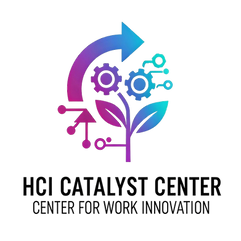Nurturing a Cross-Generational Workforce: Human Capital-Led Risk Literacy
- Clint Tripodi

- Jan 17, 2024
- 4 min read
In the dynamic sphere of Human Capital Management (HCM), where the synergy between experience and innovation shapes the future, a seismic shift is underway—the Silver Workforce Revolution. As a seasoned professional deeply entrenched in both HCM and the insurance industry, I embark on this exploration to unravel the intricate relationship between risk literacy and strategic workforce planning. Our journey takes us through the impending demographic shifts, dissecting the profound impact they hold for organizations striving to navigate the complexities of an aging workforce.
Silver Workforce Revolution: Adapting to the Age Wave
Anticipate a transformative wave in the labor force, particularly among the 64+ age group, poised to double by 2028. This demographic surge not only signals a shift in workforce dynamics, but also reveals unique challenges, prominently highlighted by the financial impact of workplace injuries. The latest report from the Workers Compensation Research Institute (WCRI) paints a vivid picture of contrasts in average claims across age groups.
Workers aged 30-49 face an average claim of $36,760, a significant figure in its own right. However, the narrative takes a compelling turn when we examine the burden faced by their 49-65+ counterparts—a staggering $53,784, marking a 52% surge. This financial contrast underscores the imperative need for strategic risk management tailored to the nuances of the aging workforce.
Mitigating expenses for older employees nearly double the costs incurred for their younger counterparts, further emphasizing the critical need for targeted support systems. The National Council on Compensation Insurance (NCCI) adds depth to this discussion by revealing that older workers not only take longer to recover from workplace injuries, but also incur higher medical costs. This wealth of data underscores the essential role of strategic risk management in fostering a workplace that supports the diverse needs of a cross-generational workforce.
Impending Workforce Transformation: Recalibrating Strategies for Continuity
As we brace ourselves for a paradigm shift in the workforce, with nearly 32% of skilled professionals on the brink of retirement, the urgency for businesses to recalibrate their strategies becomes even more evident. The essence of strategic workforce planning lies not merely in its luxury, but in its necessity for ensuring seamless transitions and organizational continuity.
Strategic workforce planning, once a forward-thinking initiative, has now become an organizational imperative. The impending workforce transformation demands proactive measures to harness the wealth of experience possessed by mature workers and ensure a smooth handover of responsibilities. This recalibration of strategies extends beyond talent management; it's a holistic approach that integrates risk literacy, acknowledging the interplay between workforce dynamics and organizational resilience.
Aging Workforce: A Demographic Tale of Reshaping the Professional Landscape
The demographic tale unfolds as we rewrite the narrative of our workforce. In the year 2000, 55 and older workers constituted a mere 11.8%. Fast forward to 2020, and this demographic has doubled to an impressive 22.7%. Projections hint at a conservative estimate of 23% by 2030, signifying that the aging workforce is not just a trend, but a dynamic force reshaping the fabric of our professional landscape.
Understanding the nuances of this demographic transformation is crucial for effective Human Capital Management (HCM). It's not merely about adapting to change; it's about leveraging the diversity of talents and addressing the evolving needs of mature workers. HCM emerges as a pivotal driver for organizational success, becoming the beacon that guides companies through the challenges and opportunities presented by a cross-generational workforce.
Navigating the Complexities: Tailored HCM Strategies Unveiled
Navigating the complexities of an aging workforce demands more than a surface-level understanding -- it requires a strategic and nuanced approach to HCM. Recognizing the diverse talents and evolving needs of mature workers, HCM becomes the linchpin for organizational success. It's not just about managing talent, but it's about understanding and harnessing the full potential of a workforce that spans multiple generations.
Recruitment Strategies: Crafting a Diverse Talent Pipeline: Tailoring recruitment strategies involves redefining the criteria for attracting talent. Embrace the experience and knowledge that mature workers bring to the table. Develop targeted recruitment campaigns that highlight the value of a diverse workforce, showcasing the advantages of intergenerational collaboration.
Retention Initiatives: Fostering a Culture of Inclusivity: Retaining experienced employees requires creating an inclusive culture that recognizes and appreciates their contributions. Implement mentorship programs that facilitate knowledge transfer between seasoned professionals and younger employees. Provide flexible work arrangements to accommodate varying needs, ultimately fostering loyalty and commitment.
Training Programs: Bridging Skill Gaps and Facilitating Continuous Learning: Tailored training programs are essential for bridging skill gaps and ensuring that employees of all ages stay relevant in a rapidly changing business landscape. Identify specific skill sets that mature workers can impart to younger colleagues, creating a knowledge-sharing ecosystem. Offer continuous learning opportunities that cater to diverse learning preferences.
Engagement Strategies: Fostering Collaboration Across Generations: Effective engagement strategies go beyond traditional approaches. Encourage cross-generational collaboration through team-building activities, mentorship circles, and collaborative projects. Recognize and celebrate the achievements of employees from different age groups, creating a sense of camaraderie and shared success.
Conclusion
As we stand at the crossroads of demographic shifts and workforce evolution, HCM emerges not merely as a functional necessity, but as a strategic imperative. Embracing risk literacy and strategic workforce planning is not just a choice; it's a necessity for those who aim not only to survive -- but to thrive in the dynamic landscape of human capital management. The Silver Workforce Revolution beckons organizations to adapt, innovate, and lead with a holistic understanding of their most valuable asset—their people.

Clint Tripodi SVP and National Human Capital Management Practice, The Liberty Company Insurance Brokers
For more information on Liberty’s National Human Capital Management Practice Group, please reach out to Clint Tripodi, Senior Vice President (National Human Capital Management Practice Leader), The Liberty Company Insurance Brokers.






















